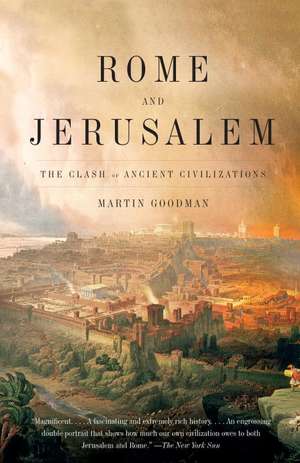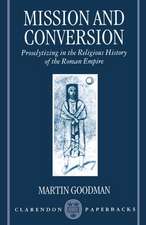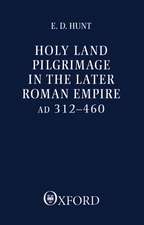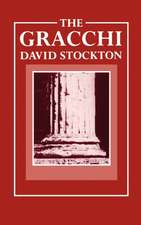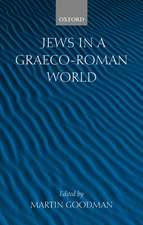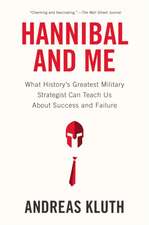Rome and Jerusalem: The Clash of Ancient Civilizations
Autor Martin Goodmanen Limba Engleză Paperback – 30 noi 2008
Martin Goodman—equally renowned in Jewish and in Roman studies—examines this conflict, its causes, and its consequences with unprecedented authority and thoroughness. He delineates the incompatibility between the cultural, political, and religious beliefs and practices of the two peoples and explains how Rome's interests were served by a policy of brutality against the Jews. At the same time, Christians began to distance themselves from their origins, becoming increasingly hostile toward Jews as Christian influence spread within the empire. This is the authoritative work of how these two great civilizations collided and how the reverberations are felt to this day.
| Toate formatele și edițiile | Preț | Express |
|---|---|---|
| Paperback (2) | 102.34 lei 24-35 zile | +38.41 lei 4-10 zile |
| Penguin Books – 30 ian 2008 | 102.34 lei 24-35 zile | +38.41 lei 4-10 zile |
| Vintage Books USA – 30 noi 2008 | 148.26 lei 3-5 săpt. |
Preț: 148.26 lei
Nou
Puncte Express: 222
Preț estimativ în valută:
28.37€ • 29.31$ • 23.61£
28.37€ • 29.31$ • 23.61£
Carte disponibilă
Livrare economică 04-18 martie
Preluare comenzi: 021 569.72.76
Specificații
ISBN-13: 9780375726132
ISBN-10: 0375726136
Pagini: 598
Ilustrații: 16 PP. ILLUS./8 MAPS
Dimensiuni: 135 x 201 x 32 mm
Greutate: 0.59 kg
Editura: Vintage Books USA
ISBN-10: 0375726136
Pagini: 598
Ilustrații: 16 PP. ILLUS./8 MAPS
Dimensiuni: 135 x 201 x 32 mm
Greutate: 0.59 kg
Editura: Vintage Books USA
Notă biografică
Martin Goodman has divided his intellectual life between the Roman and Jewish worlds. He has edited both the Journal of Roman Studies and the Journal of Jewish Studies. He has taught Roman History at Birmingham and Oxford Universities, and is currently Professor of Jewish Studies at Oxford. He is a Fellow of Wolfson College, Oxford, and of the Oxford Centre for Hebrew and Jewish Studies. In 1996 he was elected a Fellow of the British Academy. In 2002 he edited the Oxford Handbook of Jewish Studies, which was awarded a National Jewish Book Award for Scholarship. He lives with his family in Birmingham.
Extras
Chapter One: A Tale of Two Cities
Rome and Jerusalem have existed for centuries in the Western imagination as opposite ideals of grandeur and sanctity. Rome, the “Eternal City,” has long been conceived as the epitome of magnificent power imposed through military might and the force of law and as a warning of the dangers of moral corruption. The picturesque ruins of the imperial city have both fascinated and repelled, stimulating admiration for brilliant achievements by past generations and rumination on the fallibility of human desire for glory. Such images retain a hold even now in literature, art and cinema. In contrast, Jerusalem has been idealized as a holy place of revelations, miracles and spiritual intensity. The origins of these idealized images lie in the real history of these cities in the time of Jesus. At the beginning of the first millennium ce both cities were at the peak of their prosperity and grandeur, each famous throughout the Mediterranean world and beyond. They were two cities whose inhabitants came into close contact: Romans visited Jerusalem as soldiers, politicians, tourists; Jews came to Rome as suppliants, slaves or fortune-seekers. They were two cities with a culture partly shared, from the gleam of ceremonial white masonry in the summer sun to acceptance of Greek as a prestige language of the erudite and the influence of Greek architecture and philosophy. They were two cities that shared a political world fostered by friendships, alliances, patronage. But they were two cities which, as it turned out, came into conflict, with terrible results.
That a great deal can be said about both cities two thousand years ago is not entirely a matter of chance. Both Romans and Jews prized highly the art of writing, and produced large literatures. No less important, in both cases much of the literature survives to the present through a tradition of manuscript copying and preservation which was continuous from late antiquity to the Renaissance and the invention of printing. In the case of the Jews, Hebrew and Aramaic writings were preserved within the literary tradition of the rabbis, whose teachings, formulated in the first five centuries ce, laid the foundations of both medieval and modern orthodox Judaism. Jewish writings in Greek were ignored by the rabbis but preserved by Christians, who appropriated to themselves for religious edification a large number of Jewish texts composed before c.100 CE, including the Septuagint (the Greek translation of the Hebrew Bible, with additional material now commonly found in English Bibles as the Apocrypha), the philosophical treatises of Philo, the histories of Josephus, and Greek versions of more mystical Jewish writings originally composed in Hebrew or Aramaic.
Christians were also responsible for the preservation of much of the literature of ancient Rome. From the fourth century CE Christians adopted the literature of pagan Greece and Rome as their own. Some pagans, like the emperor Julian (ruled 361–3), objected that Christians could not properly teach literature about the pagan gods if they did not believe in them, and the Christian St. Jerome (c. 347–420) worried that his devotion to Ciceronian style in his Latin prose made him less devoted to his faith, but during the fifth century the great works of Greek and Latin literature came to be seen by many Christians simply as a central element in the education of Christian Romans alongside the texts composed by Christians themselves. Thus many texts survive through the pious efforts of monks, from Cassiodorus in sixth-century Italy to the industrious scholars of Byzantium as late as the fifteenth century, who saw the reproduction of manuscripts as an act of devotion, almost regardless of their contents; and from many of the pagan writings they preserved, such as Vergil’s Aeneid or the philosophical musings of Seneca, Christians would in time derive appropriate moral teachings.
The inhabitants of Jerusalem and Rome inevitably shared many experiences imposed upon them by the natural rhythms of the Mediterranean climate. For Jews, the Mediterranean was haYam haGadol, “the Great Sea”; yama, the word for “west” in Hebrew, reflected the view of the sea from Judaea. For the Romans, the Mediterranean was simply mare nostrum, “our sea,” rather like the English view of La Manche as the English Channel. Both cities sometimes experienced stifling heatwaves at the height of summer, although in Jerusalem, where snow is a great rarity, winters were milder than in Rome, where freezing temperatures are not unknown. Annual rainfall was less in Jerusalem than in Rome, and the summer drought, which could last from May to late November, was much longer and more complete, so that farmers in the Judaean hills relied more on the heavy dew precipitated by the sharp drop of air temperature at night. But in both cities people were all too aware of the potential effect of drought. In Jerusalem in 24 and 23 BCE drought led to food shortages and thus to plague, and to a dangerous lack of clothing in winter because flocks had died and there was “no wool or any other material to cover themselves.” Livy, in the time of Augustus, thought it worth including in his history of Rome the information that the year 181 BCE, nearly two centuries before, had been “remarkable for drought and the failure of the crops. The story goes that for six months it did not rain at all.”[1] Inhabitants of both cities imagined agricultural plenty in terms of wine, fruits and olives, grown on terraced hillsides, and pasturage, to supplement the grain crops cultivated on coastal plains and in valleys where the ground was sufficiently level for shallow ploughing. A Roman would have well understood the divine blessing that, if Israel will obey God’s commandments, “I will give the rain for your land in its due season, the first rain and the latter rain, so that you may gather in your grain, and your wine, and your oil. And I shall send grass in your fields for your cattle,” and the prophet Micah looking forward to the days when “they shall sit every man under his vine and under his fig tree, and none shall make them afraid.”[2]
But away from the sea, the ecology of Judaea was very different from anything to be found in Italy and in some ways Jerusalem lay outside the Mediterranean sphere. The distinctive geography of the land of Israel is a result of the great rift valley which runs southwards from Syria towards Africa and includes the long stretch of the Jordan valley, ending in the region of the Dead Sea, many feet below sea level. Moving eastwards from Jerusalem, the terraced hillsides rapidly gave way in antiquity to semi-desert. As the road descended towards Jericho, the wholly arid terrain was punctuated only by rare oases such as Jericho itself, En Gedi, and the spring of En Feshqa, which fed the strange community of Jews who inhabited Qumran, the site near which the Dead Sea scrolls were found. Josephus with some reason extolled the extraordinary fertility of such parts of the rift valley as could be sufficiently watered: on the borders of the Sea of Galilee, he claimed, fruit trees bore their produce continuously throughout the year.[3]
Josephus had good reason to exaggerate the prosperity of the land of Israel, both through natural patriotism and out of a desire to demonstrate the impressive feats of his patrons, the emperors Vespasian and Titus, but his geographical information can probably be trusted, and it is striking that he divided the Jewish homeland not into two, Judaea and Galilee, but into three: Judaea, Galilee and Peraea (which is Transjordan). Jewish territory looked not just west, towards the sea, and north, towards Galilee, but also east, towards the desert. The region east of the Jordan rises up to a basalt plateau made sufficiently fertile by precipitation of rain coming from the west to support a small number of cities in the Roman period—Philadelphia (on the site of modern Amman), Jerash and Pella among others—fed by grain production and the raising of livestock, particularly cattle. Further east still lay the semi-desert, suitable only for the grazing of sheep and goats (what the Bible called “small cattle”), and beyond the Peraea the Syrian desert itself, which was opening up precisely in the first century bce into a major highway for international trade from Mesopotamia. The success of the camel caravans was best illustrated by the growing prosperity of the oasis of Palmyra, the trading centre known in the biblical texts as Tadmor. It was in the Roman period, particularly in the two and a half centuries after the imposition of Roman authority in c. 17 ce, that the oasis reached the apogee of its wealth; many of the splendid tombs and temples on which the Palmyrenes lavished their wealth, favouring a curious amalgam of Parthian, Greek, semitic and Roman artistic traits, can still be seen.[4]
Links to the east mattered to the inhabitants of Jerusalem. Josephus even claims, in answer to the calumny that Jews could not have had a distinguished ancient history since the ancient Greeks did not write about them, that “ours is not a country with a sea coast; neither commerce nor the mixing which it enables with others has any attraction for us. Our cities are built inland, remote from the sea . . .” Certainly Judaean Jews maintained close contact in the first century with their fellow Jews in Babylonia, undeterred by the fact that Babylon was ruled by Parthia, outside the sphere of Roman control. Herod the Great established in Batanaea, to the east of the Sea of Galilee, a military colony of Babylonian Jews to provide protection against brigandage for pilgrims coming to the Jerusalem Temple from Mesopotamia. According to Josephus, the first High Priest appointed by Herod after his capture of Jerusalem in 37 BCE was a certain Ananel, a Babylonian of inferior priestly origin. According to later rabbinic tradition, the great scholar Hillel, who flourished in Jerusalem in the early first century CE, also came originally from Babylon.[5]
On the other hand, if Judaea was not a wholly Mediterranean culture, neither did it easily fall into a category defined by the fertile crescent which links this region to Mesopotamia. The region shared the use of a language, Aramaic, which had originated in upper Mesopotamia and then spread to the Levant primarily through its adoption as the language of royal administration in the Persian empire during the fifth and fourth centuries BCE; but there is no evidence that inhabitants of the fertile crescent had a sense of common destiny such as was found among some communities on the shores of the Mediterranean, particularly the Greeks. Such a sense of belonging even to a smaller regional entity is not widely attested for communities in the Near East apart from the Jews until the imposition of Roman rule, and the regional identities which then emerged seem often to have been by adoption of Roman or Greek categories. During the first three centuries CE the Near East became increasingly Roman, both in the sense of a concentration of state military resources in the eastern part of the Roman empire and through the award to existing cities of the status of Roman colony, but in the early first century CE this process was still in its infancy. Viewed from the rest of the Mediterranean world, much of the fertile crescent, variously designated as Syria, Assyria or Arabia or by other exotic names, was still an undifferentiated region of little-known barbarism. To some extent, the unhappy fortune of Jerusalem under Roman rule was a result of the city’s ambivalent position between the Mediterranean world and the Near East.[6]
Despite all the differences between the cultures of the two cities, a casual visitor to Rome and Jerusalem in the last decades of the first century BCE might have been more struck by similarities, since it was during these years that both cities metamorphosed from ramshackle agglomerations into shining testimonies to massive state expenditure. Rome, which up to the mid-first century BCE had been an unimpressive collection of brick buildings divided by winding alleyways, clustered around a small public area in the Forum and on the Capitoline hill, was remodelled with a series of new monumental public buildings and grand public spaces. Similarly, Jerusalem was expanded and transformed by Herod, to make it, as a Roman observer, the elder Pliny, proclaimed after its destruction in 70 CE, “by far the most famous city of the East.” Both cities used the most up-to-date techniques of urban planning, borrowed architectural styles from the most impressive city of the previous generation, Alexandria in Egypt, and used vaulted arches to erect platforms out from the side of hills to form level public spaces. These two ancient cities were reborn at the same time and in similar ways, but the origin of the glory of Rome was wholly different from the foundation of the splendour of Jerusalem.[7]
Rome
When Josephus came to Rome from Jerusalem for his brief visit in the early 60s CE he found the city at the height of its opulence. The huge, sprawling city lay on the river Tiber, near the west coast of Italy and above the plain of Latium. By the first century, the true origins of the city had long been lost from collective memory, and speculation about its mythical foundation allowed free range to the imagination of poets and historians. Already by the early part of the first millennium bce isolated villages, similar to others in the surrounding region of Latium, were in existence on the hills of the site that was to become Rome. These settlements grew in size and sophistication over the ensuing centuries, but the origins of the city as a single political unit are best dated to c.600 BCE, when the Forum was laid out as a public meeting space in the valley between the hilltops. From then to the mid-first century BCE, the power of the city grew inexorably. Incorporation of all of Latium was followed by a gradual expansion of influence over the rest of Italy. In the third century bce a long, bitter, but eventually successful struggle against the Phoenician trading city of Carthage, which lay on the north coast of Africa in modern Tunisia but also had many interests in Sicily and in Spain, left Rome in control of much of the coast of the western Mediterranean and, through use of a newly confident navy, of the sea routes between them. The conflict also left a residue of vocabulary and concepts to express hostility and contempt for a dangerous enemy, defined by their Punic language and customs as irremediably fickle. This early encounter was to have a formative effect on later Roman attitudes to barbarians from the Syrian East.
NOTES
[1] Joseph. AJ 15. 310; Livy 40.29.
[2] Deut. II: 14-15 (Heb.); Mic. 4: 4.
[3] Joseph. BJ 3. 516-21.
[4] Threefold division: Joseph. BJ 3. 35-58; on Palmyra, see I. Browning, Palmyra (London, 1979).
[5] "Not a country with a sea coast": Joseph. Ap. I. 60; on Babylonian Jews, see J. Neusner, A History of the Jews in Babylonia, vol. I: The Parthian Period (London, rev. edn. 1969).
[6] F. Millar, The Roman Near East, 31 BC-AD 337 (Cambridge, Mass., and London, 1993).
[7] Plin. HN 5.15 (70).
From the Hardcover edition.
Rome and Jerusalem have existed for centuries in the Western imagination as opposite ideals of grandeur and sanctity. Rome, the “Eternal City,” has long been conceived as the epitome of magnificent power imposed through military might and the force of law and as a warning of the dangers of moral corruption. The picturesque ruins of the imperial city have both fascinated and repelled, stimulating admiration for brilliant achievements by past generations and rumination on the fallibility of human desire for glory. Such images retain a hold even now in literature, art and cinema. In contrast, Jerusalem has been idealized as a holy place of revelations, miracles and spiritual intensity. The origins of these idealized images lie in the real history of these cities in the time of Jesus. At the beginning of the first millennium ce both cities were at the peak of their prosperity and grandeur, each famous throughout the Mediterranean world and beyond. They were two cities whose inhabitants came into close contact: Romans visited Jerusalem as soldiers, politicians, tourists; Jews came to Rome as suppliants, slaves or fortune-seekers. They were two cities with a culture partly shared, from the gleam of ceremonial white masonry in the summer sun to acceptance of Greek as a prestige language of the erudite and the influence of Greek architecture and philosophy. They were two cities that shared a political world fostered by friendships, alliances, patronage. But they were two cities which, as it turned out, came into conflict, with terrible results.
That a great deal can be said about both cities two thousand years ago is not entirely a matter of chance. Both Romans and Jews prized highly the art of writing, and produced large literatures. No less important, in both cases much of the literature survives to the present through a tradition of manuscript copying and preservation which was continuous from late antiquity to the Renaissance and the invention of printing. In the case of the Jews, Hebrew and Aramaic writings were preserved within the literary tradition of the rabbis, whose teachings, formulated in the first five centuries ce, laid the foundations of both medieval and modern orthodox Judaism. Jewish writings in Greek were ignored by the rabbis but preserved by Christians, who appropriated to themselves for religious edification a large number of Jewish texts composed before c.100 CE, including the Septuagint (the Greek translation of the Hebrew Bible, with additional material now commonly found in English Bibles as the Apocrypha), the philosophical treatises of Philo, the histories of Josephus, and Greek versions of more mystical Jewish writings originally composed in Hebrew or Aramaic.
Christians were also responsible for the preservation of much of the literature of ancient Rome. From the fourth century CE Christians adopted the literature of pagan Greece and Rome as their own. Some pagans, like the emperor Julian (ruled 361–3), objected that Christians could not properly teach literature about the pagan gods if they did not believe in them, and the Christian St. Jerome (c. 347–420) worried that his devotion to Ciceronian style in his Latin prose made him less devoted to his faith, but during the fifth century the great works of Greek and Latin literature came to be seen by many Christians simply as a central element in the education of Christian Romans alongside the texts composed by Christians themselves. Thus many texts survive through the pious efforts of monks, from Cassiodorus in sixth-century Italy to the industrious scholars of Byzantium as late as the fifteenth century, who saw the reproduction of manuscripts as an act of devotion, almost regardless of their contents; and from many of the pagan writings they preserved, such as Vergil’s Aeneid or the philosophical musings of Seneca, Christians would in time derive appropriate moral teachings.
The inhabitants of Jerusalem and Rome inevitably shared many experiences imposed upon them by the natural rhythms of the Mediterranean climate. For Jews, the Mediterranean was haYam haGadol, “the Great Sea”; yama, the word for “west” in Hebrew, reflected the view of the sea from Judaea. For the Romans, the Mediterranean was simply mare nostrum, “our sea,” rather like the English view of La Manche as the English Channel. Both cities sometimes experienced stifling heatwaves at the height of summer, although in Jerusalem, where snow is a great rarity, winters were milder than in Rome, where freezing temperatures are not unknown. Annual rainfall was less in Jerusalem than in Rome, and the summer drought, which could last from May to late November, was much longer and more complete, so that farmers in the Judaean hills relied more on the heavy dew precipitated by the sharp drop of air temperature at night. But in both cities people were all too aware of the potential effect of drought. In Jerusalem in 24 and 23 BCE drought led to food shortages and thus to plague, and to a dangerous lack of clothing in winter because flocks had died and there was “no wool or any other material to cover themselves.” Livy, in the time of Augustus, thought it worth including in his history of Rome the information that the year 181 BCE, nearly two centuries before, had been “remarkable for drought and the failure of the crops. The story goes that for six months it did not rain at all.”[1] Inhabitants of both cities imagined agricultural plenty in terms of wine, fruits and olives, grown on terraced hillsides, and pasturage, to supplement the grain crops cultivated on coastal plains and in valleys where the ground was sufficiently level for shallow ploughing. A Roman would have well understood the divine blessing that, if Israel will obey God’s commandments, “I will give the rain for your land in its due season, the first rain and the latter rain, so that you may gather in your grain, and your wine, and your oil. And I shall send grass in your fields for your cattle,” and the prophet Micah looking forward to the days when “they shall sit every man under his vine and under his fig tree, and none shall make them afraid.”[2]
But away from the sea, the ecology of Judaea was very different from anything to be found in Italy and in some ways Jerusalem lay outside the Mediterranean sphere. The distinctive geography of the land of Israel is a result of the great rift valley which runs southwards from Syria towards Africa and includes the long stretch of the Jordan valley, ending in the region of the Dead Sea, many feet below sea level. Moving eastwards from Jerusalem, the terraced hillsides rapidly gave way in antiquity to semi-desert. As the road descended towards Jericho, the wholly arid terrain was punctuated only by rare oases such as Jericho itself, En Gedi, and the spring of En Feshqa, which fed the strange community of Jews who inhabited Qumran, the site near which the Dead Sea scrolls were found. Josephus with some reason extolled the extraordinary fertility of such parts of the rift valley as could be sufficiently watered: on the borders of the Sea of Galilee, he claimed, fruit trees bore their produce continuously throughout the year.[3]
Josephus had good reason to exaggerate the prosperity of the land of Israel, both through natural patriotism and out of a desire to demonstrate the impressive feats of his patrons, the emperors Vespasian and Titus, but his geographical information can probably be trusted, and it is striking that he divided the Jewish homeland not into two, Judaea and Galilee, but into three: Judaea, Galilee and Peraea (which is Transjordan). Jewish territory looked not just west, towards the sea, and north, towards Galilee, but also east, towards the desert. The region east of the Jordan rises up to a basalt plateau made sufficiently fertile by precipitation of rain coming from the west to support a small number of cities in the Roman period—Philadelphia (on the site of modern Amman), Jerash and Pella among others—fed by grain production and the raising of livestock, particularly cattle. Further east still lay the semi-desert, suitable only for the grazing of sheep and goats (what the Bible called “small cattle”), and beyond the Peraea the Syrian desert itself, which was opening up precisely in the first century bce into a major highway for international trade from Mesopotamia. The success of the camel caravans was best illustrated by the growing prosperity of the oasis of Palmyra, the trading centre known in the biblical texts as Tadmor. It was in the Roman period, particularly in the two and a half centuries after the imposition of Roman authority in c. 17 ce, that the oasis reached the apogee of its wealth; many of the splendid tombs and temples on which the Palmyrenes lavished their wealth, favouring a curious amalgam of Parthian, Greek, semitic and Roman artistic traits, can still be seen.[4]
Links to the east mattered to the inhabitants of Jerusalem. Josephus even claims, in answer to the calumny that Jews could not have had a distinguished ancient history since the ancient Greeks did not write about them, that “ours is not a country with a sea coast; neither commerce nor the mixing which it enables with others has any attraction for us. Our cities are built inland, remote from the sea . . .” Certainly Judaean Jews maintained close contact in the first century with their fellow Jews in Babylonia, undeterred by the fact that Babylon was ruled by Parthia, outside the sphere of Roman control. Herod the Great established in Batanaea, to the east of the Sea of Galilee, a military colony of Babylonian Jews to provide protection against brigandage for pilgrims coming to the Jerusalem Temple from Mesopotamia. According to Josephus, the first High Priest appointed by Herod after his capture of Jerusalem in 37 BCE was a certain Ananel, a Babylonian of inferior priestly origin. According to later rabbinic tradition, the great scholar Hillel, who flourished in Jerusalem in the early first century CE, also came originally from Babylon.[5]
On the other hand, if Judaea was not a wholly Mediterranean culture, neither did it easily fall into a category defined by the fertile crescent which links this region to Mesopotamia. The region shared the use of a language, Aramaic, which had originated in upper Mesopotamia and then spread to the Levant primarily through its adoption as the language of royal administration in the Persian empire during the fifth and fourth centuries BCE; but there is no evidence that inhabitants of the fertile crescent had a sense of common destiny such as was found among some communities on the shores of the Mediterranean, particularly the Greeks. Such a sense of belonging even to a smaller regional entity is not widely attested for communities in the Near East apart from the Jews until the imposition of Roman rule, and the regional identities which then emerged seem often to have been by adoption of Roman or Greek categories. During the first three centuries CE the Near East became increasingly Roman, both in the sense of a concentration of state military resources in the eastern part of the Roman empire and through the award to existing cities of the status of Roman colony, but in the early first century CE this process was still in its infancy. Viewed from the rest of the Mediterranean world, much of the fertile crescent, variously designated as Syria, Assyria or Arabia or by other exotic names, was still an undifferentiated region of little-known barbarism. To some extent, the unhappy fortune of Jerusalem under Roman rule was a result of the city’s ambivalent position between the Mediterranean world and the Near East.[6]
Despite all the differences between the cultures of the two cities, a casual visitor to Rome and Jerusalem in the last decades of the first century BCE might have been more struck by similarities, since it was during these years that both cities metamorphosed from ramshackle agglomerations into shining testimonies to massive state expenditure. Rome, which up to the mid-first century BCE had been an unimpressive collection of brick buildings divided by winding alleyways, clustered around a small public area in the Forum and on the Capitoline hill, was remodelled with a series of new monumental public buildings and grand public spaces. Similarly, Jerusalem was expanded and transformed by Herod, to make it, as a Roman observer, the elder Pliny, proclaimed after its destruction in 70 CE, “by far the most famous city of the East.” Both cities used the most up-to-date techniques of urban planning, borrowed architectural styles from the most impressive city of the previous generation, Alexandria in Egypt, and used vaulted arches to erect platforms out from the side of hills to form level public spaces. These two ancient cities were reborn at the same time and in similar ways, but the origin of the glory of Rome was wholly different from the foundation of the splendour of Jerusalem.[7]
Rome
When Josephus came to Rome from Jerusalem for his brief visit in the early 60s CE he found the city at the height of its opulence. The huge, sprawling city lay on the river Tiber, near the west coast of Italy and above the plain of Latium. By the first century, the true origins of the city had long been lost from collective memory, and speculation about its mythical foundation allowed free range to the imagination of poets and historians. Already by the early part of the first millennium bce isolated villages, similar to others in the surrounding region of Latium, were in existence on the hills of the site that was to become Rome. These settlements grew in size and sophistication over the ensuing centuries, but the origins of the city as a single political unit are best dated to c.600 BCE, when the Forum was laid out as a public meeting space in the valley between the hilltops. From then to the mid-first century BCE, the power of the city grew inexorably. Incorporation of all of Latium was followed by a gradual expansion of influence over the rest of Italy. In the third century bce a long, bitter, but eventually successful struggle against the Phoenician trading city of Carthage, which lay on the north coast of Africa in modern Tunisia but also had many interests in Sicily and in Spain, left Rome in control of much of the coast of the western Mediterranean and, through use of a newly confident navy, of the sea routes between them. The conflict also left a residue of vocabulary and concepts to express hostility and contempt for a dangerous enemy, defined by their Punic language and customs as irremediably fickle. This early encounter was to have a formative effect on later Roman attitudes to barbarians from the Syrian East.
NOTES
[1] Joseph. AJ 15. 310; Livy 40.29.
[2] Deut. II: 14-15 (Heb.); Mic. 4: 4.
[3] Joseph. BJ 3. 516-21.
[4] Threefold division: Joseph. BJ 3. 35-58; on Palmyra, see I. Browning, Palmyra (London, 1979).
[5] "Not a country with a sea coast": Joseph. Ap. I. 60; on Babylonian Jews, see J. Neusner, A History of the Jews in Babylonia, vol. I: The Parthian Period (London, rev. edn. 1969).
[6] F. Millar, The Roman Near East, 31 BC-AD 337 (Cambridge, Mass., and London, 1993).
[7] Plin. HN 5.15 (70).
From the Hardcover edition.
Recenzii
“Magnificent. . . . A fascinating and extremely rich history. . . . An engrossing double portrait that shows how much our own civilization owes to both Jerusalem and Rome.” —The New York Sun“Innovative. . . . A complicated bit of history brilliantly told.” —St. Louis Post-Dispatch“Well-written, detailed and meticulous. . . . Provides an intricate examination of life in the first century.” —The Dallas Morning News“A triumph. Goodman's scrupulous care with his sources, his eye for telling detail and his easy prose style combine to produce a work that will reward any reader.” —Jerusalem Post
Cuprins
Illustrations, Figures and Maps
Acknowledgements
Introduction: The Main Witness
Prologue: The Destruction of Jerusalem
Part one: A Mediterranean World
Chapter one: A Tale of Two Cities
Chapter two: One World Under Rome
Chapter three: Diversity and Toleration
Part two: Romans and Jews
Chapter four: Identities
Chapter five: Communities
Chapter six: Perspectives
Chapter seven: Lifestyles
Chapter eight: Government
Chapter nine: Politics
Chapter ten: Romans and Jews
Part three: Conflict
Chapter eleven: The Road to Destruction
Chapter twelve: Reactions
Chapter thirteen: The Growth of the Church
Chapter fourteen: A New Rome and a New Jerusalem
Epilogue: The Origins of Antisemitism
Notes
Further Reading
Index
Acknowledgements
Introduction: The Main Witness
Prologue: The Destruction of Jerusalem
Part one: A Mediterranean World
Chapter one: A Tale of Two Cities
Chapter two: One World Under Rome
Chapter three: Diversity and Toleration
Part two: Romans and Jews
Chapter four: Identities
Chapter five: Communities
Chapter six: Perspectives
Chapter seven: Lifestyles
Chapter eight: Government
Chapter nine: Politics
Chapter ten: Romans and Jews
Part three: Conflict
Chapter eleven: The Road to Destruction
Chapter twelve: Reactions
Chapter thirteen: The Growth of the Church
Chapter fourteen: A New Rome and a New Jerusalem
Epilogue: The Origins of Antisemitism
Notes
Further Reading
Index
